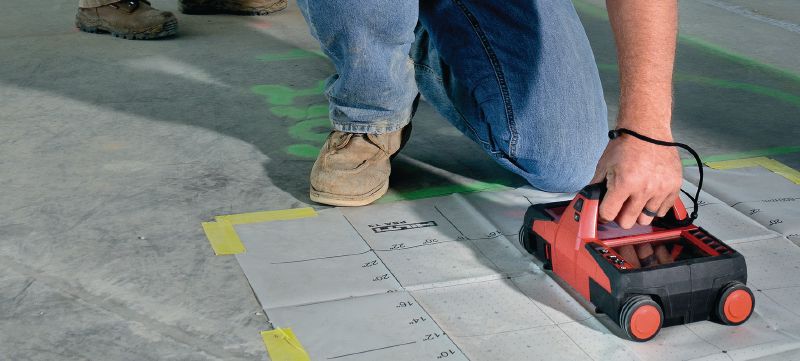Advanced Concrete Scanning Techniques: Ensuring Structural Stability
Advanced Concrete Scanning Techniques: Ensuring Structural Stability
Blog Article
Unveil the Transformative Power of Concrete Scanning in Making The Most Of Performance and Safety And Security
Concrete scanning has actually emerged as a vital tool in the construction industry, supplying unequaled benefits in improving job effectiveness and guaranteeing safety and security requirements. The transformative power of concrete scanning lies in its capability to offer real-time data and comprehensive understandings, transforming just how tasks are prepared and executed.
Relevance of Concrete Scanning
Making sure the structural integrity and safety and security of building jobs begins with the crucial action of carrying out detailed concrete scanning. Concrete scanning is a non-destructive method used to spot and map subsurface aspects within concrete frameworks.
In addition, concrete scanning aids in maximizing task timelines and spending plan by preventing unforeseen prices and hold-ups that may develop due to unanticipated blockages within the concrete. Eventually, spending in detailed concrete scanning is a proactive method that improves both performance and safety in building jobs.
Exactly How Concrete Scanning Functions
Concrete scanning runs as a crucial tool in building and construction jobs by employing innovative innovations to spot and map subsurface elements without causing architectural damages. Ground Passing Through Radar (GPR) and Electromagnetic Induction (EMI) are two main methods utilized in concrete scanning.
Throughout the scanning process, the information collected is examined in real-time, permitting instant recognition of possible hazards or challenges beneath the surface. This info help in decision-making, making sure that building and construction activities continue securely and efficiently. In addition, 3D imaging software can be used to create topographic maps of the subsurface components, even more boosting project preparation and implementation. By utilizing these innovative modern technologies, concrete scanning dramatically minimizes the risk of pricey damages and injuries on building websites.
Advantages of Concrete Scanning
One of the key advantages of concrete scanning is the capability to find and situate embedded things such as rebar, post-tension wires, and channels accurately. Concrete scanning helps in planning and making a lot more effectively, as it offers specific info concerning the area and depth of structural parts.

Situation Researches: Concrete Scanning Success

In an additional instance, a construction firm made use of 3D concrete scanning to examine the condition of aging concrete frameworks in a historic building. The in-depth scans offered useful understandings into the degree of deterioration and aided prioritize maintenance initiatives effectively. By proactively addressing areas of issue determined via scanning, the company was able to prolong the life expectancy of the framework and ensure resident security.
These instance studies highlight the transformative power of concrete scanning in boosting performance, accuracy, and security in building tasks.
Implementing Concrete Scanning in Projects
Carrying out advanced scanning innovations throughout building tasks has come to be significantly essential for boosting accuracy and safety. By incorporating concrete scanning right into task preparation and implementation, construction teams can identify potential risks, such as rebar or post-tension wires, hidden within concrete structures. This aggressive method decreases the risk of mishaps, hold-ups, and costly rework, inevitably causing extra reliable project timelines and budget plans.
To apply concrete scanning properly, task managers should team up carefully with seasoned scanning specialists to establish one of the most ideal scanning strategies for the specific project requirements. Involving scanning professionals from the onset his response of a job makes it possible for the group to create comprehensive scanning plans that resolve key areas of concern and make sure extensive data collection.
Moreover, including concrete scanning into normal job operations can enhance decision-making processes, as real-time check information gives immediate understandings into the problem of concrete structures - Concrete Scanning. This data-driven strategy helps with informed analytical and allows groups to make adjustments immediately, fostering a society of efficiency and security throughout the project lifecycle

Conclusion
In final thought, concrete scanning plays an important role in boosting effectiveness and safety in construction tasks. By utilizing advanced modern technology to map and find out underlying structures within concrete, this procedure assists to stop pricey errors, make certain architectural stability, and minimize dangers on website. With the ability to reveal hidden components and supply exact data, concrete scanning confirms to be a beneficial device for enhancing Get More Information project results and optimizing overall success.
Concrete scanning is a non-destructive technique made use of to detect and map subsurface elements within concrete frameworks. In addition, concrete scanning helps in maximizing job timelines and budget plan by staying clear of unanticipated costs and hold-ups that might occur due to unforeseen blockages within the concrete. One significant instance research entails a massive restoration job where concrete scanning played a vital role in guaranteeing task success.In an additional instance, a building and construction company utilized 3D concrete scanning to analyze the condition of aging concrete frameworks in a historic building. By integrating concrete scanning into task planning and implementation, construction groups can identify potential threats, such as rebar or post-tension cable televisions, concealed within concrete frameworks.
Report this page